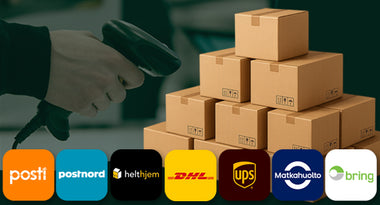Before you can create the best possible order processing workflows for your Shopify store, you should first understand what you are processing. The type of orders, customers and products you are dealing with are a good starting point.
You should also consider the product picking in your warehouse and how you should approach it. Even if you're not processing that much daily orders yet, it's better to think these before growing big, as it gets a lot harder when you grow. When your sales grow, if you have any mess caused by bad order processing workflows in your warehouse - they grows as well.
Don't be afraid to think it all over again if needed, as this is really important part of your daily life as a merchant.
1. Categorize your Shopify orders for your order processing flow
Start by analyzing the types of orders your Shopify store handles. Are they bulk wholesale orders, small individual orders, or a mix of both? Are you shipping both domestic and international? Do you sell products that require extra attention in fulfillment? The complexity of the orders can determine how you structure your printing workflow. For example, smaller orders might only require a packing slip, while larger orders may need detailed picking lists and invoices.
A common way to approach this is to think about the differencies in your order processing flow amongst the orders. Some of the most used ways for Shopify merchants to differentiate their order processing are:
- Carriers pick up the orders at different time of the day
- Adding something extra for VIP customers
- You sell pre-orders that will be shipped later
- You sell customized products that require manual work while processing the order
- You ship orders from different locations

2. How do you want to pick the items?
Decide whether you want to pick items for individual orders or combine items from multiple orders to be picked in one go (picking lists for batch picking). The method you choose can save time depending on your inventory setup and how large your order volumes are. For example, batch picking can reduce the number of trips to storage or amount of steps taken, especially if items are stored across multiple shelves or locations.

Shelf numbers for items?
Incorporating shelf numbers or bin locations into your order templates is crucial for efficient picking. You can print these shelf locations directly on your picking lists or packing slips, so you can quickly locate items. This reduces confusion and speeds up the process, especially if you have a larger inventory.
Here's an example how you can use Printrooster to display shelf number from variant metafield to your order prints:
LIQUID | Shelf number from variant metafield{{ article.metafields.custom.code_snippet_1 | metafield_tag }}
Do you wish to sort products in a certain order in templates?
If your items are stored in a specific arrangement in your warehouse or storage, sorting them accordingly on your printed picking list or packing slip can save a lot of time. For example, sorting by shelf location, category, or even SKU order could optimize your picker’s route, minimizing backtracking and speeding up fulfillment.
Here's an example how you can use Printrooster to sort the line items in your order prints using variant metafield's shelf number:
LIQUID | Sort line items by variant metafield{{ article.metafields.custom.code_snippet_2 | metafield_tag }}
Create Your Scheme for Shelf Numbers
Creating a scheme for your warehouse shelf numbering is very crucial. It's important that it's in alphabetical order and also that it's easy to read for the person picking the items. Good starting point for this would be thinking about own number for 1. aisle, then 2. shelf distance from entering the aisle and finally 3. shelf height. You'd then have three different markings. Be sure to reserve the same amount of letters/numbers for each of those three.
For most, two digits are enough, so the first isle would be 01, the first distance in that isle would be 001 and the lowest (or highest, if you want) would be 01. Then the shelf number for the product in that shelf would be: 01-01-01. Therefor, when you display your items in shelf numbering sequence, you would have all the items in your first aisle coming up first in your pick lists. If you don't have many aisles, you could make it a bit shorter, or even use alphabets for that. In this case we could use A for the first aisle, this way the shelf number would be A-01-01. If two digits are not enough or you have a reason to believe that soon it's not enough, you should use more digits. With three digits, the alphabetical shelf number would be A-001-001.
The most important thing is that all of the shelf numbers are in alphabetical order.
Picking lists
A well-organized picking list can be a game-changer for picking products efficiently. Determine the information that’s most useful for your team: product names, quantities, SKUs, and shelf location. You can consolidate similar items across multiple orders into a single picking list to streamline batch picking.

3. How do you want to sort the orders?
Sorting your orders in the right sequence can help you prioritize fulfillment. For instance, you may want to prioritize high-value orders, international shipments, or express deliveries first. After grouping orders based on shipping methods, geographical regions, or any other priority criteria relevant to your business, you might want to optimize the sequence of the individual orders inside your printing batches.
Some merchants prefer to sort their orders by order number or the time the order was created. Sorting by order number helps when following a sequential approach to processing, while sorting by order time may help
you fulfill orders that came in first or during a specific period (like a flash sale or promotion). This can also help with bulk printing workflows, where you print a batch of orders based on the time window in
which they were placed.
4. What documents you want to print for the orders?
Decide whether you need to include an invoice or packing slip with each order - or maybe something completely different based on the order data. A packing slip typically contains only product and shipping details, while an invoice includes pricing information. Many customers expect a packing slip to be enclosed, and certain businesses, like B2B or wholesale, often require invoices.




